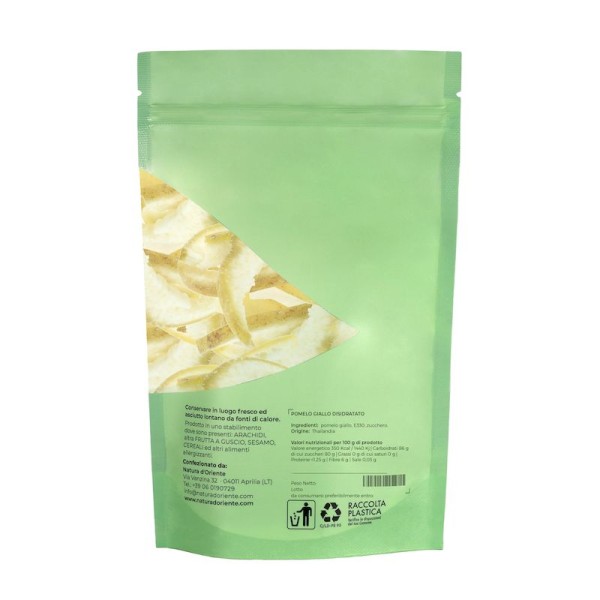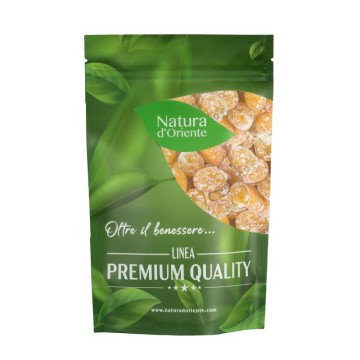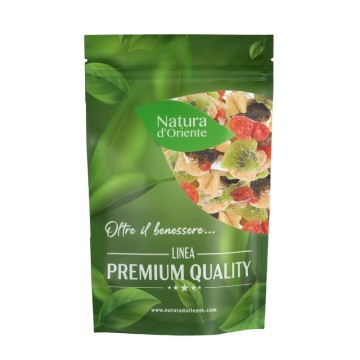Dehydrated yellow pomelo
This particular fruit is part of the citrus family of which it can be considered one of the first to appear on our land. In fact, the pomelo is a very ancient citrus fruit, already known in the East for the many benefits it could bring to people's health.
Today we would say those willing to look for it, because it is rare in our local markets, but it is easily available in the dehydrated pomelo version.
Dried yellow pomelo: properties and benefits
The large Asian citrus fruit has a shape similar to that of a pear, and a thick skin, which varies in color from green to yellow. In this sheet, we offer dehydrated yellow pomelo.
As a flavor, the pomelo has a taste similar to grapefruit, but sweeter.
Immediately entering the scope of its beneficial properties, the pomelo makes available to us different vitamins, minerals and antioxidants. These are elements that make this fruit healthy as well as tasty for our diet.
The pomelo is a good source of vitamin C, which we know as a powerful antioxidant, often cited as a booster for the immune system. In particular, however, as an antioxidant it prevents cellular damage caused by free radicals.
This fruit also contains other vitamins (such as vitamin B6), magnesium and minerals. Among them is potassium, which regulates the fluid balance in the body and blood pressure.
In terms of sports nutrition, the yellow pomelo contains good levels of mineral salts and vitamins, such as magnesium and potassium, which help replenish the nutrients lost during physical effort, also reducing cramps.
A dose of dried yellow pomelo also allows you to take in a lot of fiber, to help you meet your needs for insoluble fiber to prevent constipation.
In addition to this anti-constipation action, dietary fiber is a food source for healthy bacteria in the gut, which keeps the intestinal biome in excellent balance. The fiber of the yellow pomelo, as for many fibers contained in the fruit, has been associated by nutritional research with the improvement of intestinal functions.
Other substances in the fruit are proteins which, together with the fibres, help the feeling of satiety, for the purpose of a slimming diet. Dehydrated Yellow Pomelo can contribute to the diet of those who want to lose weight, with its action that absorbs and reduces the sugar and starch content in the body.
In addition to vitamin C, the main antioxidants of the pomelo are naringenin and naringin, i.e. substances present in citrus fruits, which add to lycopene, an antioxidant of the fruit that fights inflammation , helps the well-being of the heart both by hindering the oxidation of cholesterol and by regulating triglycerides in the blood
Thanks to the many substances contained in the pomelo, its consumption can also help in the anti-aging function, preventing skin damage caused by harmful free radicals.
Origins and History of cultivation
Known for millennia, the pomelo is native to southern Asia and Malaysia, and was introduced to China around the first century AD. From there it spread and continues to survive. It grew spontaneously, along the banks of rivers and streams, even in various territories including the islands of Tonga, Hawaii and Fiji.
It arrived in Europe with trade between East and West in the fourteenth century, and since then its name has been changed in many countries. It is called Citrus maxima, Citrus grandis, Chinese grapefruit, pommelo, boongon, Jeruk Bali, jabong, shaddock, Jeruk Bali, pomelo, pummelo, pampaleone. It has often been confused with yuzu, a very similar Chinese fruit, which is actually a different species. In particular, it has been exchanged over time with grapefruit, but it is larger, has a sweet pulp, a thick and spongy skin.
Its color varies from light green to yellow when ripe, and in our version it is precisely the dehydrated yellow pomelo, with a very specific colour. The color of the pulp also varies from light yellow to pink or red, like grapefruit.
From secothere the pomelo peel is used to make jam, in Chinese cuisine, or used as a sweetener to make candies.
Today it is grown in China, Thailand, Taiwan, Japan, southern India, the Tahiti Islands, Vietnam, Indonesia, Israel, the Philippines and partly also in the USA. In Italy it is grown in Sicily.
It has not become very popular as a crop, in many parts of the world, because the plant takes years to flower and bear fruit.
A curiosity: the fruit is also known as shaddock, named after the English captain Shaddock, who introduced the pomelo seed from the Malay archipelago to the West Indies in the 17th century. The captain is also remembered in Liguria, where the pomelo is known as sciaddocco.
Only the inner pulp is edible palatable, but the yellow pomelo is highly coveted for its nutritional value.
Plant and Fruit
The Yellow Pomelo plant is the Citrus maxima or Citrus grandis, native to China and considered one of the three species from which all citrus fruits derive, together with citron and mandarin.
Citrus maxima grows best in warm and rainy climates, even if it resists frost, in fact it is grown well in tropical and subtropical areas, on humid and marshy soils.
The pomelo is propagated mainly by grafting, and reaches a height of about 15 meters. The plant is very vigorous, thorny, with large, elliptical-oval leaves, in a spherical crown. The flowers are large, arranged both in clusters (from 2 to 10 pomelos) and as isolated pomelos.
The pomelo fruit has an average diameter of about 5-7 centimeters, but grows up to 30 cm, and can weigh up to 10 kg.
The green-yellow skin, sometimes pink or red, has a spongy white substance under the skin, called albedo. This forms the entire upper part of the fruit, the narrow part.
The various colors and texture of the pulp vary according to the types of pomelo (sweet Khao horn, Khao namphung, sweet and sour Khao paen and Khao puang, Thongdi).</p >
The shape of the pomelo is not spherical, but looks like a pear shape (in some countries the shape is assimilated to a teardrop). The pulp, divided into slices, is drier than other citrus fruits, and reaches colors from light yellow to pink to red. The taste is similar to grapefruit but sweeter.
Usually the fruits ripen around February, and the conservation of the fruit is about a month. For this reason, it is often found on the market as a dehydrated pomelo. Pomelo is mainly used as a table fruit, especially as a dried pomelo or its juice is used.
Nutritional values of dehydrated Yellow Pomelo
This fruit contains about 350 Kcal per 100 grams, in dehydrated form it has no fat, but provides minerals, vitamins and fibre.
The nutritional values of Dried Yellow Pomelo show good levels of vitamin C (about 60 mg / 100 g) and vitamin A (IU 8). It also contains vitamin substances which in 100 grams are: Thiamine (about 0.035 mg), Riboflavin (about 0.27 mg) and Niacin (about 0.22 mg), in addition to Vitamin B-6 (about 0.36 mg).
In addition, the yellow pomelo makes minerals such as potassium (about 200 mg / 100g), calcium (about 4 mg / 100 g), phosphorus (about 17 mg / 100 g), magnesium (about 6 mg / 100 g) and zinc (about 0.08 mg / 100 g).
How to consume dehydrated Yellow Pomelo in the kitchen or as a snack
The fruit has been used for centuries in Southeast Asian cuisine, known for its citrus flavor and aromatic enough to flavor many dishes.</ p>
It does not have the acidic taste found in a grapefruit or lemon, and is used in salads or to enhance the flavor of a legume soup. It is usually associated with desserts by inserting the pomelo into fruit salads, and as a garnish for duck, chicken, pork or shrimp dishes.
The dehydrated Yellow Pomelo in slices is perfect to be stored and eaten as a hunger-busting snack. It can be added to mixes of dried fruit and cereals, or for toppings on ice creams, muffins, cakes, cupcakes and other desserts.
Dried Yellow Pomelo is also ideal for creating energy bars, or forIt can be added as an ingredient to yoghurts, flavoring teas and infusions.
Even for smoothies or cocktails, dried Yellow Pomelo can make them original and exotic.
Dried yellow pomelo: side effects and contraindications
There are no particular contraindications to taking Yellow Pomelo in the correct doses. We know, however, that the pomelo contains sugars. like other types of dried fruit, and excessive use is therefore not recommended for those suffering from diabetes - pomelos can increase blood sugar levels.
In addition, like grapefruits, pomelos contain compounds called furanocoumarins, which can affect the metabolism of statins – a factor to consider for those taking medications affecting this metabolism. In high quantities it could interact with antiarrhythmic drugs, corticosteroids, calcium channel blockers, immunosuppressants and protease inhibitors.
In large doses, dried Yellow Pomelo could cause discomfort for those suffering from gastritis.













 No reward points for this product.
No reward points for this product.













![Natural dehydrated grapefruit without added sugar [NATURADORIENTE]](https://www.naturadoriente.com/10190-home_default/pompelmo-naturale-disidratato-senza-aggiunta-di-zucchero.jpg)

